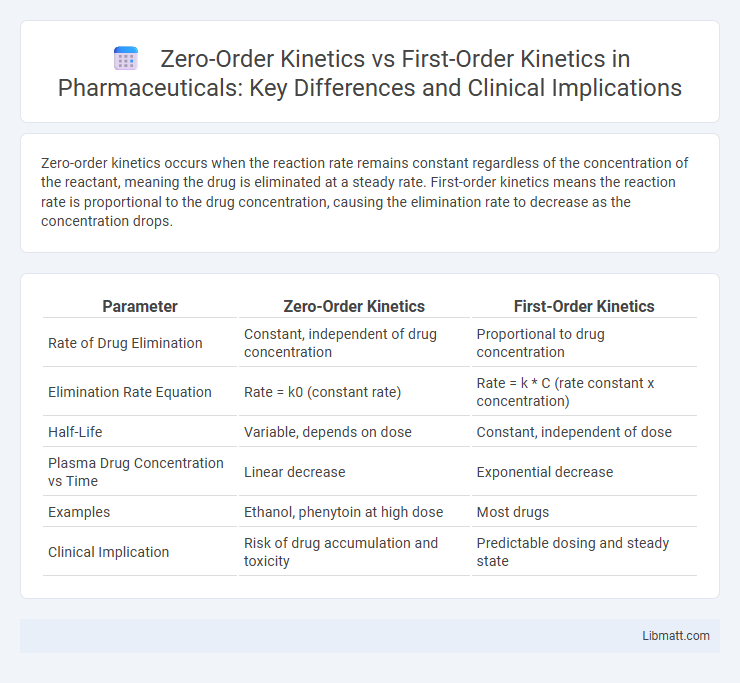Zero-order kinetics occurs when the reaction rate remains constant regardless of the concentration of the reactant, meaning the drug is eliminated at a steady rate. First-order kinetics means the reaction rate is proportional to the drug concentration, causing the elimination rate to decrease as the concentration drops.
Table of Comparison
| Parameter | Zero-Order Kinetics | First-Order Kinetics |
|---|---|---|
| Rate of Drug Elimination | Constant, independent of drug concentration | Proportional to drug concentration |
| Elimination Rate Equation | Rate = k0 (constant rate) | Rate = k * C (rate constant x concentration) |
| Half-Life | Variable, depends on dose | Constant, independent of dose |
| Plasma Drug Concentration vs Time | Linear decrease | Exponential decrease |
| Examples | Ethanol, phenytoin at high dose | Most drugs |
| Clinical Implication | Risk of drug accumulation and toxicity | Predictable dosing and steady state |
Introduction to Reaction Kinetics
Zero-order kinetics describes reactions where the rate remains constant regardless of reactant concentration, often observed in enzyme-substrate systems at saturation or surface catalysis. First-order kinetics features reaction rates directly proportional to the concentration of a single reactant, commonly seen in radioactive decay and many simple decomposition processes. Understanding these kinetics provides fundamental insights into the mechanisms and speed of chemical reactions.
Defining Zero-Order Kinetics
Zero-order kinetics describe a reaction rate that remains constant regardless of the concentration of the reactant, meaning the rate is independent of substrate concentration. This occurs when enzymes or catalysts become saturated, such as in drug metabolism at high plasma levels. The defining characteristic is a linear decrease in drug concentration over time, contrasting with first-order kinetics where the rate depends proportionally on drug concentration.
Understanding First-Order Kinetics
First-order kinetics describes a reaction rate proportional to the concentration of a single reactant, meaning the rate decreases exponentially over time as the reactant is consumed. This kinetic model is commonly observed in drug metabolism and elimination processes, where the plasma concentration decreases by a constant fraction per unit time. Understanding first-order kinetics is crucial for accurately predicting drug half-life, dosage intervals, and steady-state concentrations in pharmacokinetics.
Key Differences Between Zero-Order and First-Order Kinetics
Zero-order kinetics occurs when the reaction rate remains constant regardless of reactant concentration, whereas first-order kinetics involves a reaction rate proportional to the concentration of one reactant. In zero-order reactions, the concentration decreases linearly over time, while in first-order reactions, it follows an exponential decay curve. These distinct kinetic behaviors are crucial for understanding drug metabolism, chemical reaction design, and pharmacokinetics modeling.
Mathematical Representation and Equations
Zero-order kinetics follows the equation \( C = C_0 - kt \), where the drug concentration decreases linearly over time at a constant rate \( k \). In first-order kinetics, the concentration decays exponentially according to \( C = C_0 e^{-kt} \), with the rate proportional to the current concentration. Understanding these mathematical models helps you predict drug elimination and optimize dosing regimens for effective therapy.
Real-World Examples of Zero-Order Kinetics
Zero-order kinetics occur when the rate of a reaction is constant and independent of reactant concentration, commonly seen in processes such as alcohol metabolism and zero-order drug elimination like phenytoin. In these real-world examples, the enzymes responsible for metabolism become saturated, causing the body to eliminate substances at a fixed rate. Understanding zero-order kinetics is crucial for accurately predicting Your drug metabolism and avoiding toxicity in medications with narrow therapeutic windows.
Real-World Examples of First-Order Kinetics
First-order kinetics is commonly observed in the metabolism of many drugs, such as alcohol and phenytoin, where the rate of elimination is proportional to the drug concentration in the bloodstream. Radioactive decay processes, including carbon-14 dating, also follow first-order kinetics, characterized by a constant half-life regardless of the remaining quantity. Enzymatic reactions involving substrate concentration often exhibit first-order kinetics under low substrate levels, as seen with certain pharmacokinetic profiles in clinical settings.
Factors Influencing Kinetic Order
The kinetic order of a reaction depends on factors such as the concentration of reactants, enzyme saturation, and reaction environment. Zero-order kinetics typically occur when the enzyme or catalyst is saturated, making the reaction rate independent of substrate concentration. Your understanding of these factors is crucial for accurately predicting how reaction rates change under different conditions in pharmacokinetics or chemical processes.
Importance in Pharmacology and Drug Dosing
Zero-order kinetics occurs when a drug is metabolized at a constant rate regardless of concentration, leading to linear elimination, which is critical in avoiding toxicity for drugs like phenytoin and aspirin. First-order kinetics involves drug elimination proportional to its concentration, enabling predictable dosing and steady-state achievement as seen with most medications such as propranolol and digoxin. Understanding these kinetic models is essential in pharmacology to optimize dosing regimens, ensure therapeutic efficacy, and prevent adverse drug reactions.
Summary and Comparative Analysis
Zero-order kinetics describe reactions with a constant rate independent of reactant concentration, while first-order kinetics depend on the concentration of one reactant, leading to an exponential decay in reactant levels. In zero-order reactions, the rate remains constant, causing a linear decrease in concentration over time, whereas first-order reactions exhibit a rate proportional to the reactant, resulting in a half-life that is constant regardless of initial concentration. Understanding these differences helps you predict reaction behavior and optimize conditions for biochemical or pharmaceutical processes.
Zero-order kinetics vs first-order kinetics Infographic

 libmatt.com
libmatt.com